
Jack Geerlings crouches down at the shoreline to sift through a bed of stones. He picks up a small rough rock and turns it over in his hands. “This one is too coarse,” he says and flicks it back to the pile. Geerlings is after something a little more interesting.
Slowly, he walks along the vast sweep of beach, his gaze rarely lifting from the ground. “The sunlight helps to reveal the stones,” he says, bending to pick up and inspect rocks one by one. A little further on, he turns over a small red-brown stone, the colour and texture of a chestnut. “This one could be jasper,” he says, with more enthusiasm.
At a distance, the stones look like any others found along New Zealand’s rugged Southland coast, but here, at Orepuki – or Gemstone beach – a closer look reveals a bed of riches.

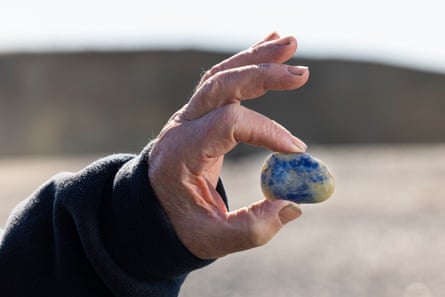
Jasper, hydro-grossular garnet in pinks, greens and yellows, patterned fossilised worm-trails, spotted argillite, frosty white quartz, speckled granites, pink-flecked rhodonite and – in rare cases – the unmistakeable blue of sapphire, colour the low-tide line.
The gems likely started their lengthy journey to Gemstone Beach during the last ice age, roughly 16,000-18,000 years ago. As the landscape of Fiordland – the dramatic mountainous region of the lower South Island – altered and released its rocks, the debris was pulled into the flow of the Waiau River and onwards into the sea. The rocks are shaped and polished as they tumble through rivers and tides, until the ocean currents push them back towards land, where finally they embed in the cliffs and blanket the shore.
When the tide recedes, the beach is scattered with a geological lolly scramble. And waiting in the wings are rockhounds – dedicated rock fossickers hoping to fill their goody bag.
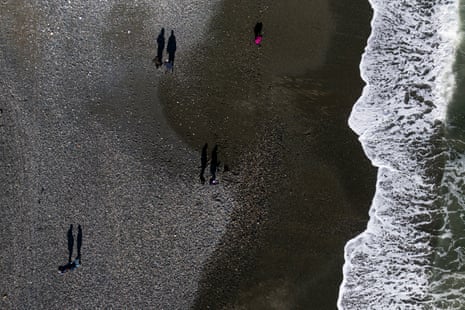
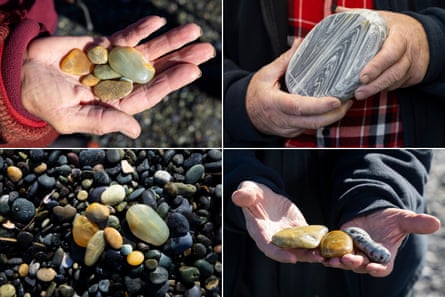
Geerlings, a retired dairy-farmer turned avid rock collector, is one of a number of rockhounds who have scoured this shore for years.
Occasionally, he hits the gemstone jackpot.
Geerlings dips his hand into the pocket of his overalls and retrieves his prized possession, a buttery yellow rock streaked with bright blue.
The lucky find came 10 years ago, after a cliff crumbled into the beach and exposed its treasure.
“And then I found this sapphire,” he says, holding it proudly up to the light.
Finding a sapphire is rare – Geerlings has found just six in his many years of looking – and there is little one can do to up their chances.
“When I found that big one, I was just lucky to be on the beach.”
Geerlings is so dedicated to his hobby, he has built a cavernous three bay shed to process and house his impressive collection from around the country. The shelves glitter with stones that swirl like milky galaxies, fossilised wood the colour of brindled fur, and glossy gems like gumdrops.
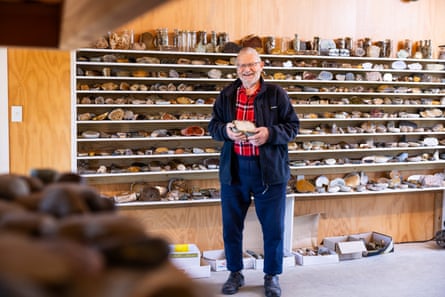
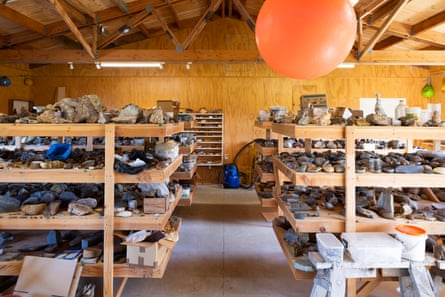
When asked what excites him about collecting rocks, he simply says: “I fell in love with it.”
It is a sentiment shared by other enthusiasts. Marion Troon, a member of the Southland geological and lapidary club, caught “gem fever” after a trip to Australia some decades ago.
Troon regularly rummages at Gemstone beach and is generous with her tips to new fossickers. Word spreads quickly – more than once, she is interrupted by strangers hoping she can name their finds.
The hydro-grossular garnet is the most common of the semi-precious gemstones found here, she says. They are distinguishable not just for their colour, but their texture – rub a quartz through your fingers and it will feel rough; a garnet will feel smooth and almost “greasy”.
Looking for stones is a form of “stress relief”, Troon says. “And they have healing qualities.”
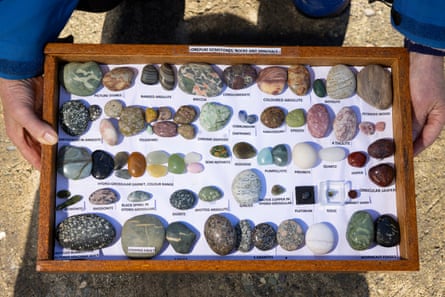
A long social history
An hour east, in Invercargill, Lloyd Esler is sitting on his couch, in a living room that could be mistaken for a natural history museum – the shelves are lined with a lifetime of finds: fossils, bones, books, curios and gems.
The historian, educator and author has an insatiable interest in local history – he has published 12 books on the region and has another 7 in the works. Orepuki, or Gemstone beach – has featured in his work.
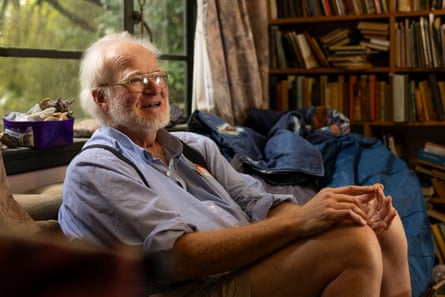
Long before tourists and collectors populated the beach in search of treasure, Māori used the hard garnet stones to polish and sharpen toki, a cutting tool. When Europeans arrived in Orepuki, they discovered gold, and a mining settlement was established.
The area also became the site of New Zealand’s only, and short-lived, platinum smelter. With just 47kg extracted from gravels between 1897 and 1907, the smelter soon ceased operations, but its platinum made its way into the 1937 British Imperial State Crown.
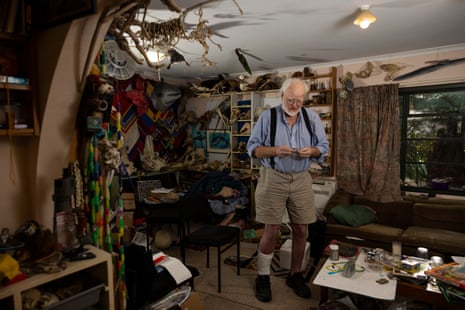
Though not entirely unique to New Zealand (a few other beaches also yield semi-precious stones), Orepuki is striking, he says. “It has one of the best assortments of unusual pebbles in New Zealand.”
“A combination of ocean currents, the shape of the coast and the proximity of the Waiau River – the source of many of the stones – means that the rarities are concentrated along a short strip of beach on account of their weight.”
People are permitted to take stones from the beach within reason. No more than a cubic metre is allowed to be taken and they must be gathered by hand, the regional council Environment Southland said.
With gems regularly washing ashore, and others released from the cliffs, there is little risk of the gems disappearing, Esler adds.
‘I’m hunting treasure’
It is a bright Monday afternoon in the middle of winter and Gemstone beach is dotted with figures, picking at the shoreline like seabirds. In the distance, the jagged spine of Fiordland curls toward the sea; behind them, farmland stretches inland.
Part way down the beach is Trudy Anderson – a local woman whose pockets are slumping under the weight of her morning’s finds.
“I’m addicted,” she says. ‘“I am hunting treasure.”
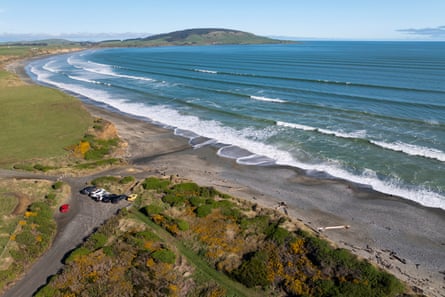
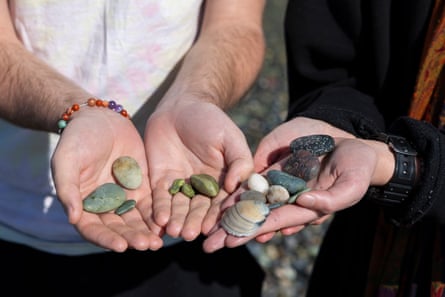
Anderson has been travelling to the beach for 30 years and is a frequent visitor but even she is not as diehard as some. “Some people do it religiously every morning”, she says. “People make jewellery out of them, some sell them.”
Further up the beach, Mark and Deborah Barber – a couple holidaying from Australia – are giddy over their finds.
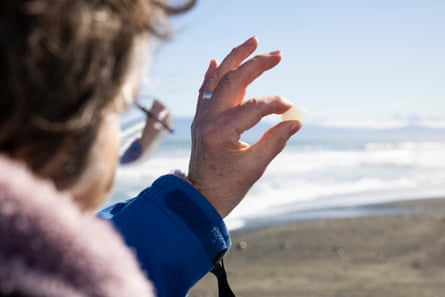
“The garnet, apparently is the bees knees,” Mark says, holding up a small pale green gem that becomes semi-translucent in the sunlight. “I’m hoping to find my retirement.”
That may be a tall order – the gems are unlikely to make you rich, but searching for them can lead to an afternoon of childlike glee.
“He’s been trying to drag me out of here for the last hour,” Deborah says. “And I’m saying ‘no – this is my happy place, I want to stay here forever’.”
 Print
Print


